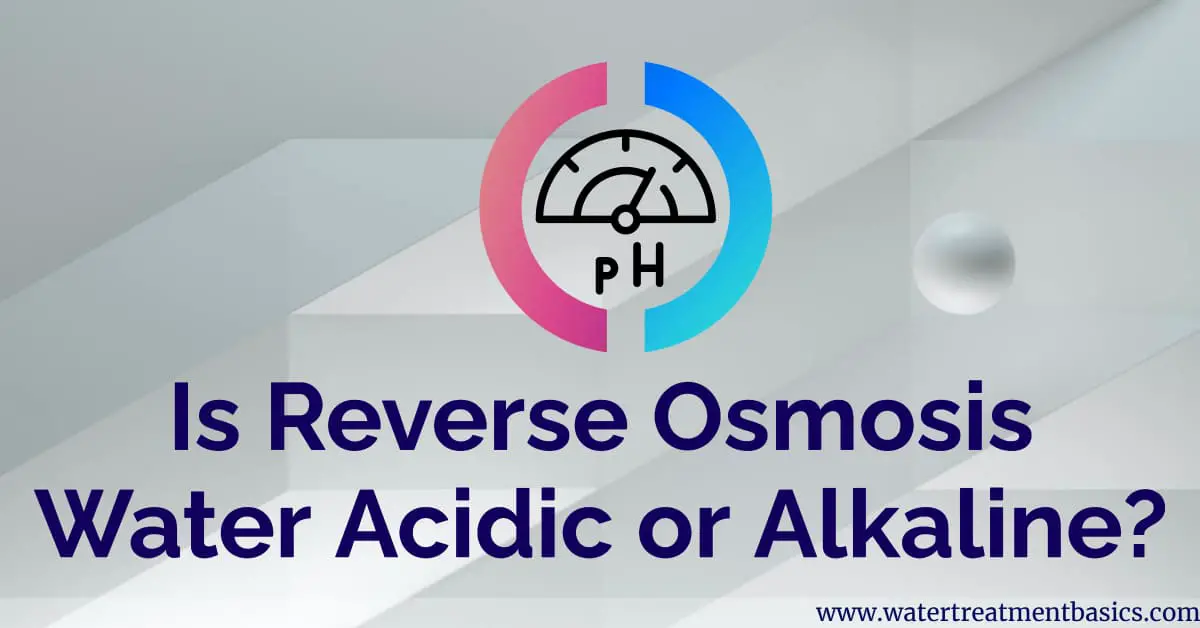Reverse osmosis (RO) is a process that can remove suspended solids, bacteria, and other pollutants from water. This makes it a popular choice for drinking water, but is reverse osmosis water acidic or alkaline?
This important question is worth exploring further, as there are some potential health risks associated with acidic water. In this blog post, we will look at the science behind reverse osmosis water, how it is made, and the pH level of reverse osmosis water.
I will also discuss the potential health risks of drinking acidic water and the benefits of drinking alkaline water. By the end of this post, you should have a better understanding of reverse osmosis water and the potential health implications of drinking it.
Why is Reverse Osmosis Water Acidic?
Reverse osmosis, or RO, is a process that removes a vast majority of impurities from water through filtration. The end product of this process is water that is almost pure and has a neutral pH of 7.
However, when reverse osmosis product water is exposed to air, its pH level drops to an acidic range of 6-6.5. This occurs because pure water has a tendency to absorb CO2 from the air, that can produce carbonic acid (H2CO3) which can quickly decrease its pH level.
H2O+ CO2 —–> H2CO3 (Carbonic Acid)
As a result, reverse osmosis water is not alkaline, as alkaline water is defined as having a pH greater than 7.
What is Acidity?
Acidity refers to the acidity or basicity of a solution, typically measured by its pH. A pH of 7 is neutral, a pH less than 7 is acidic, and a pH greater than 7 is basic. The pH scale ranges from 0 to 14, with 0 being the most acidic and 14 being the most basic.
The acidity of a solution is determined by the concentration of hydrogen ions (H+) present in the solution. A solution with a high concentration of H+ ions is considered to be acidic, while a solution with a low concentration of H+ ions is considered to be basic.
What is Alkalinity?
Alkalinity is a measure of the ability of a solution to neutralize acids. It is a measure of the concentration of bases (opposite of acids) in a solution and is typically expressed as the equivalent concentration of hydroxide ions (OH-).
Alkalinity is typically measured in water systems, such as rivers, lakes, and oceans, and is an important characteristic for maintaining the chemical balance of aquatic ecosystems.
Alkalinity can be caused by various substances such as carbonates, bicarbonates, hydroxides, and other dissolved compounds that can neutralize acids. A solution with a high alkalinity is said to be basic or alkaline, while a solution with a low alkalinity is considered to be acidic.
Alkalinity is typically measured in milligrams per liter (mg/L) or parts per million (ppm) of calcium carbonate (CaCO3).
Does Reverse Osmosis Remove Acidity?
The short answer to this question is no, reverse osmosis does not remove acidity.
Reverse osmosis works by forcing water through a semi-permeable membrane which separates the dissolved solids from the water. The process does not remove acidic or alkaline substances from the water, only dissolved solids like salts and minerals.
Reverse osmosis is most commonly used for water purification, not for adjusting the pH of water. To reduce the acidity of water, it is best to use a water filter specifically designed for pH adjustment.
How to Test pH of Reverse Osmosis Water?
To test the pH of reverse osmosis water, you will need to use an electronic pH meter or a litmus test paper. For an electronic pH meter, simply dip the probe into the water and take the reading.
If you are using litmus test paper, dip the strip into the water for a few seconds and then compare the color of the strip to the included color chart.
The pH of reverse osmosis water should be around 7, which is neutral. If it is lower than 7, the water is acidic. If it is higher than 7, the water is alkaline.
- pH test strips: One way to test the pH of reverse osmosis water is to use pH test strips. These strips are available at many stores and are relatively inexpensive. To use them, simply dip the strip into the water and compare the color of the strip to the chart provided to determine the pH of the water.
- pH meters: Another option for testing the pH of reverse osmosis water is to use a pH meter. These devices are more accurate than pH test strips and are often used in laboratory settings. However, they can be more expensive and may require calibration.
How to Make Reverse Osmosis Water Alkaline?
Making reverse osmosis water alkaline is an easy process. You will need to purchase a home alkalizing system or a filter that adds minerals, such as calcium and magnesium, to the water.
You will also need to purchase an alkaline solution, such as baking soda or potassium bicarbonate, to add to the water. Once the water has been filtered and the alkaline solution has been added, it will become alkaline with a pH level of 8 or higher.
Keep in mind that the alkalinity of the water will decrease over time and will need to be re-alkalized periodically.
Conclusion
In conclusion, the reverse osmosis process does not produce acidic water. Instead, the purified water produced by reverse osmosis has a neutral to slightly alkaline pH level. This is due to the filtration process removing impurities and minerals which may cause the water to be acidic. Reverse osmosis water is also free of chemicals and other contaminants, making it a great choice for those looking for safe and healthy drinking water.
Additional Resources
- Links to further information on reverse osmosis and pH in drinking water:How Reverse Osmosis Works (https://www.explainthatstuff.com/reverseosmosis.html)
- The pH Scale and Water (https://www.epa.gov/sites/production/files/2015-09/documents/ph.pdf)
- pH in Drinking Water (https://www.who.int/water_sanitation_health/dwq/chemicals
